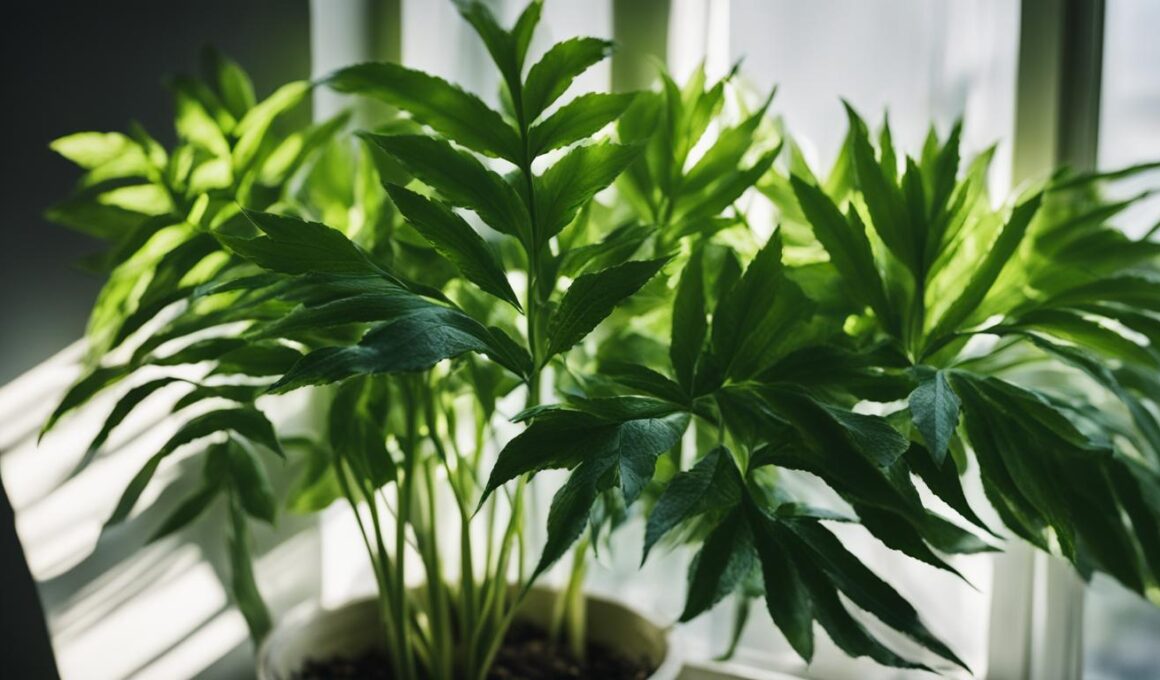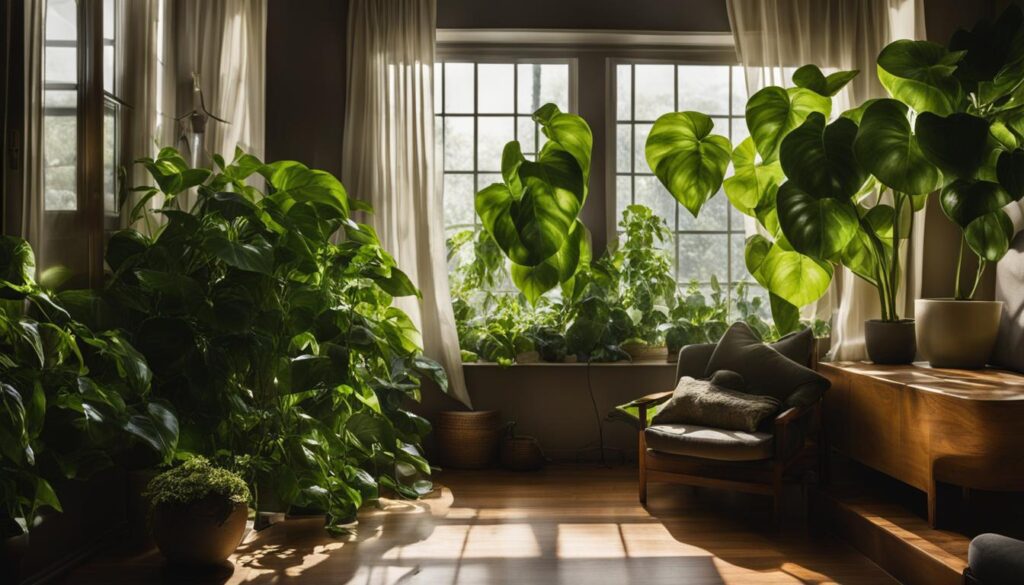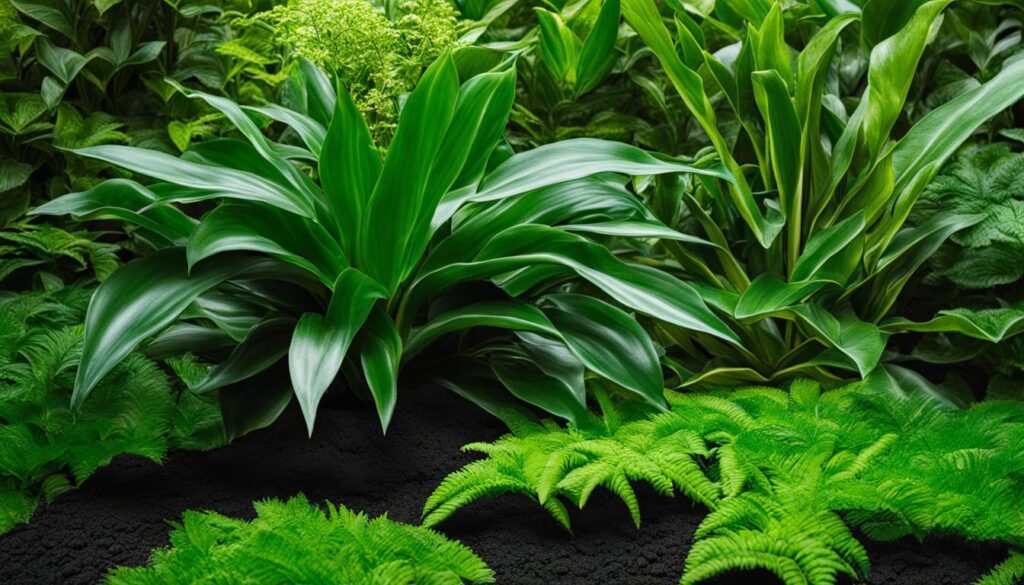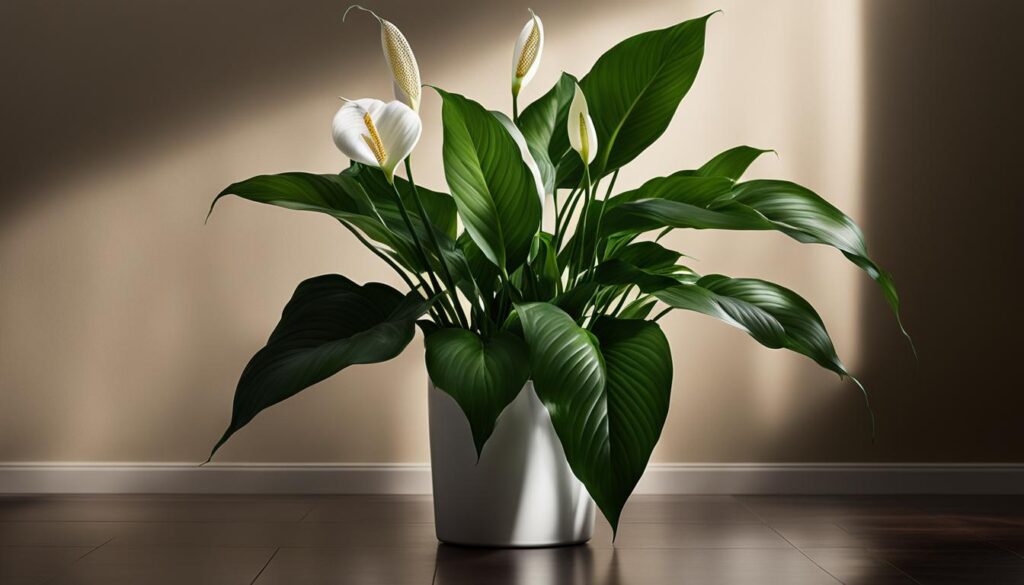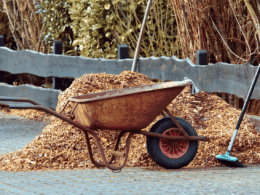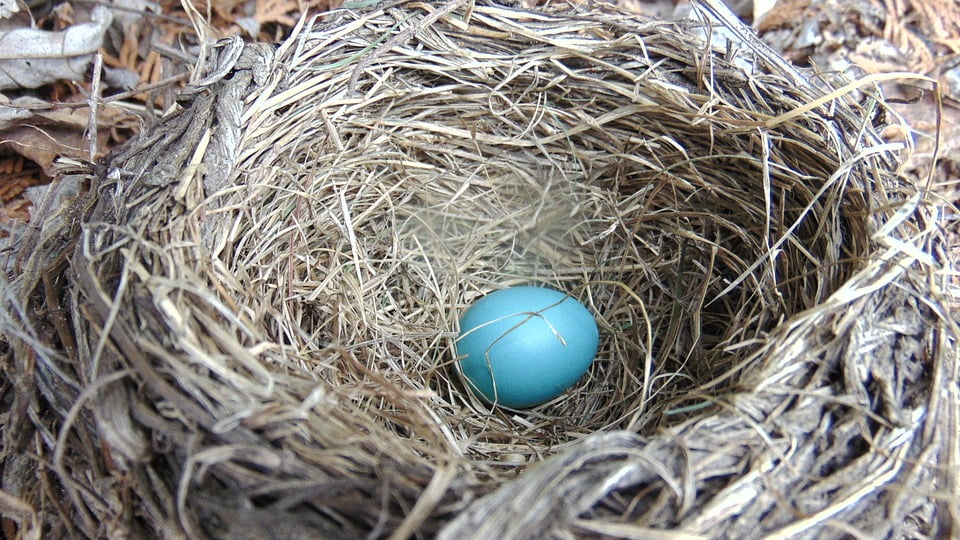If you have a home that receives limited sunlight and you’re looking to add some greenery to your space, don’t fret. There are several true low light houseplants that thrive in low light conditions. While all plants require some amount of light to survive, these low light houseplants can tolerate and even thrive in dimly lit areas. Here are some top choices for indoor plants that are perfect for low light conditions.
Key Takeaways:
- True low light houseplants can tolerate and thrive in low light conditions.
- These plants are perfect for adding greenery to areas with limited sunlight.
- Some top choices for low light houseplants include pothos, cast iron plant, peace lily, Chinese evergreen, and bird’s nest fern.
- Each plant has specific care requirements, so be sure to understand their needs.
- Experiment with different plants and care techniques to find the best fit for your space.
Understanding the Needs of Low Light Houseplants
Low light houseplants have different requirements compared to plants that thrive in sunny environments. While they can tolerate less light, it’s important to understand their specific needs to ensure their well-being. Proper care and attention will help these plants thrive in your indoor garden, even in low light conditions.
Plant Care Tips for Low Light Houseplants
- Choose the right plant: Select low light houseplants that are known to tolerate and thrive in low light conditions. Some popular choices include pothos, cast iron plant, peace lily, Chinese evergreen, and bird’s nest fern.
- Consider indirect light: While low light houseplants can survive in dimly lit areas, they still need some amount of light to photosynthesize. Place them near windows where they can receive indirect light, or use artificial grow lights specifically designed for low light plants.
- Water sparingly: Low light houseplants have slower growth rates compared to their sun-loving counterparts. Overwatering can lead to root rot, so it’s important to let the soil dry out between waterings. Check the moisture level by sticking your finger about an inch into the soil – if it feels dry, it’s time to water.
- Monitor humidity levels: Many low light houseplants thrive in higher humidity levels. To create a humid environment, place a tray filled with water near your plants or use a humidifier. This will help prevent their leaves from drying out in dry indoor conditions.
- Fertilize sparingly: Low light houseplants require less fertilizer compared to those in brighter locations. Use a balanced, water-soluble fertilizer diluted to half-strength every few months during the growing season, and reduce or eliminate fertilization during the winter months when plants are dormant.
“Proper care and attention will help these plants thrive in your indoor garden, even in low light conditions.”
Understanding the needs of your low light houseplants is crucial for their overall health and growth. By providing them with the right amount of light, water, and humidity, you can create a thriving indoor garden in even the darkest corners of your home. Experiment with different low light houseplants and care techniques to find the perfect combination that suits your space and brings natural beauty to your indoor environment.
Pothos – A True Low Light Houseplant
If you’re looking for a versatile and low-maintenance houseplant that thrives in low light conditions, look no further than the Pothos. Also known as devil’s ivy, this true low light hanging plant is a popular choice for indoor gardening enthusiasts.
One of the reasons why Pothos is a great choice for low light environments is its ability to tolerate and even thrive in dimly lit areas. Its trailing vines and heart-shaped leaves add a touch of greenery to any space, making it a perfect choice for those looking to bring the outdoors inside.
In addition to its adaptability to low light conditions, Pothos is also known for its low-maintenance nature. It is tolerant of neglect, making it an ideal choice for busy individuals or those who may not have a green thumb. The solid green variety of Pothos is particularly well-suited for low light environments, as variegated leaves reduce light absorption.
To care for your Pothos plant, provide it with occasional watering when the top inch of soil feels dry and avoid overwatering. It can also benefit from regular pruning to encourage bushier growth. With minimal effort, you can enjoy the beauty of Pothos in your low light space.
Caring for Pothos in Low Light
Here are some care tips to ensure your Pothos thrives in low light conditions:
- Place your Pothos plant near a window where it can receive indirect sunlight. However, it can also adapt well to artificial light sources such as fluorescent bulbs.
- Water your Pothos sparingly, allowing the top inch of soil to dry out before watering again. Overwatering can lead to root rot, so it’s important to strike a balance.
- Ensure proper drainage by using a well-draining potting mix and a pot with drainage holes. This will prevent water from accumulating and causing damage to the roots.
- Regularly dust the leaves of your Pothos plant to keep them clean and free from dust particles that can hinder photosynthesis.
- Consider misting your Pothos plant occasionally to provide it with some humidity, especially if the air in your home is dry.
By following these care tips, you can enjoy the beauty of Pothos in your low light space and create a green oasis in your home.
Cast Iron Plant – Hardy and Resilient
The cast iron plant, also known as Aspidistra elatior, is a true low light tolerant plant that thrives in dark corners of your home. Its ability to withstand low light conditions makes it a perfect choice for areas with limited sunlight. This hardy plant is aptly named for its resilience and ability to thrive even in poorly lit rooms.
The cast iron plant is known for its deep green, glossy leaves that grow upright, creating a lush and vibrant display. Its dense foliage adds a touch of elegance to any space, while its tolerance for neglect and low light make it an ideal plant for busy individuals or those with a less-than-green thumb.
Whether placed in a dim hallway or tucked away in a corner, the cast iron plant will bring life and greenery to even the darkest areas of your home. Its low light tolerance, combined with its ability to withstand long periods without watering, makes it a low-maintenance plant that thrives in challenging conditions.
The Benefits of Cast Iron Plant:
- Thrives in low light conditions
- Tolerates neglect and infrequent watering
- Adds greenery to dark corners and hallways
- Requires minimal maintenance
- Improves air quality by filtering toxins
“The cast iron plant is a true survivor. Its ability to thrive in low light conditions and withstand neglect makes it a top choice for dark corners and challenging areas of your home.”
Tips for Growing Cast Iron Plant:
- Place the plant in an area with low to moderate light, away from direct sunlight.
- Water the plant sparingly, allowing the soil to dry out slightly between waterings.
- Use a well-draining potting mix to prevent waterlogged roots.
- Avoid excessive fertilization, as the cast iron plant prefers nutrient-poor soil.
- Dust the leaves regularly to keep them clean and free from debris.
Peace Lily – Brighten Up Dark Spaces
The peace lily is a beautiful true low light houseplant that thrives in heavily-shaded areas. It is perfect for brightening up any darker corner in your house. The peace lily blooms throughout the year and can tolerate low light conditions. However, it is important to consistently water the plant and avoid overwatering as it does not tolerate excessive moisture.
This low light indoor plant is known for its distinctive white flowers that contrast against its rich green foliage. The peace lily is not only visually appealing but also offers several benefits for indoor spaces. It is known to improve air quality by filtering out common pollutants such as formaldehyde, benzene, and carbon monoxide.
To care for your peace lily, keep the soil consistently moist but not soggy. Water the plant when the top inch of soil feels dry to the touch. Mist the leaves occasionally to provide some humidity, especially in drier indoor environments. It is important to keep peace lilies out of direct sunlight as it can damage the leaves. Instead, place them in areas with indirect or filtered light.
The peace lily is a versatile low light indoor plant that can thrive in various containers and settings. You can display it in pots or hanging baskets, making it a great choice for adding greenery to different areas of your home. Whether you place it in your living room, bedroom, or office, the peace lily will bring life and beauty to any heavily-shaded space.
Chinese Evergreen – Sturdy and Variegated
The Chinese evergreen is a popular choice for indoor gardening enthusiasts due to its ability to thrive in low light conditions. This low light performer features variegated leaves, adding a touch of elegance and color to any space. Its sturdy nature makes it an ideal houseplant for those looking for a low-maintenance option that can withstand neglect to some extent.
The Chinese evergreen’s two-toned leaves come in a range of beautiful colors, from silvery greens to vibrant pinks, providing a visually appealing contrast. This plant can adapt to various light levels, but it truly excels in low light environments where it can showcase its unique leaf patterns. Its adaptability to low light conditions makes it a versatile choice for any room in your home.
When caring for the Chinese evergreen, it is important to provide consistent moisture and warm temperatures. Avoid overwatering, as this can lead to root rot. Let the soil dry out slightly between waterings to strike a balance for optimal growth. Additionally, misting the leaves regularly can help maintain humidity levels, which this plant appreciates.
Growing Tips for Chinese Evergreen:
- Place the Chinese evergreen in a spot with indirect or filtered light, away from direct sunlight.
- Water the plant when the top inch of soil feels dry to the touch, but avoid overwatering.
- Ensure good drainage by using well-draining potting soil and a container with drainage holes.
- Mist the leaves occasionally to increase humidity levels, especially during dry seasons.
- Keep the plant away from drafts and cold temperatures, as it prefers warmth.
The Chinese evergreen is a low light performer that brings both beauty and resilience to any low light environment. With its variegated leaves and adaptability to different light levels, it is an excellent choice for adding color and vibrancy to any space in your home.
Bird’s Nest Fern – Thrives in Moderate to Low Light
The bird’s nest fern is an ideal true low light houseplant that thrives in moderate to low light conditions. Its unique foliage and adaptability make it a popular choice for indoor gardening enthusiasts. With its ability to tolerate lower light levels, it can bring life and freshness to areas in your home that receive limited sunlight.
This fern prefers warm temperatures and high humidity levels, making it well-suited for environments such as a muggy bathroom with a window. Its flat, wavy fronds create a lush and tropical atmosphere, adding a touch of natural beauty to dull bathrooms.
The bird’s nest fern can adjust its leaf growth in response to light levels. In moderate to low light conditions, it will grow its leaves flatter, maximizing its exposure to available light. This allows it to thrive even in areas with limited natural light. In environments with indirect sunlight, the fern’s leaves may develop a more wrinkled appearance, but it will still continue to grow and flourish.
Overall, the bird’s nest fern is a stunning and resilient choice for low light conditions. Its ability to thrive in moderate to low light, coupled with its striking foliage, makes it an excellent addition to any indoor garden. Try placing it in areas with high humidity levels and enjoy the beauty of this adaptable houseplant.
Benefits of the Bird’s Nest Fern
- Thrives in moderate to low light conditions
- Adds a tropical touch to bathrooms and other high-humidity areas
- Adjusts leaf growth to optimize light absorption
- Tolerant of neglect and low-maintenance
Add a touch of natural beauty to dull bathrooms with the vibrant and resilient bird’s nest fern. Its ability to thrive in moderate to low light conditions, coupled with its flat, wavy fronds, makes it an excellent choice for indoor gardening enthusiasts. This adaptable houseplant is sure to bring a lush and tropical atmosphere to any space it inhabits.
Conclusion:
In conclusion, true low light houseplants are a great way to add greenery to your home, even in areas with limited sunlight. While all plants require some light to survive, there are many options available that can tolerate and even thrive in low light conditions.
Pothos, cast iron plant, peace lily, Chinese evergreen, bird’s nest fern, and other low light houseplants mentioned in this article are perfect choices for adding natural beauty to dimly lit areas of your home. These true low light houseplants can tolerate low light conditions and still flourish, making them ideal for indoor gardening in spaces that receive limited sunlight.
Experiment with different plants and care techniques to find the best fit for your space and enjoy the benefits of indoor gardening in low light conditions. Whether you have a dark hallway, a dimly lit room, or a shaded corner, there is a true low light houseplant that can bring life and vibrancy to your home.
Can Fertilizer Help Low Light Houseplants Thrive in a Hydroponic System?
Yes, hydroponic fertilizer options can definitely help low light houseplants thrive in a hydroponic system. Some fertilizers are specifically formulated for use in hydroponic systems, providing the necessary nutrients that may be lacking in a low light environment. These options can help optimize plant growth and ensure healthy, vibrant houseplants.
FAQ
Do low light houseplants need any light to survive?
Yes, all plants require some amount of light to survive. However, low light houseplants can tolerate and even thrive in dimly lit areas.
What are some care tips for low light houseplants?
Low light houseplants have different requirements compared to plants that thrive in sunny environments. It’s important to understand their specific needs, such as consistent moisture and warm temperatures, to ensure their well-being.
Why is pothos a popular choice for low light environments?
Pothos, also known as devil’s ivy, is a versatile true low light houseplant that can thrive in various light conditions, including low light. It has trailing vines and heart-shaped leaves, making it a popular choice for adding greenery to dimly lit spaces.
What makes the cast iron plant suitable for dark corners?
The cast iron plant is named for its resilience and ability to thrive in poorly lit rooms. It is a low light tolerant plant that can withstand long periods without watering and limited sunlight, making it an excellent choice for adding greenery to dark hallways and corners.
Can peace lilies tolerate low light conditions?
Yes, peace lilies are beautiful true low light houseplants that can thrive in heavily-shaded areas. They are perfect for brightening up any darker corner in your house and bloom throughout the year.
What makes the Chinese evergreen a good choice for low light environments?
The Chinese evergreen is a sturdy low light performer and an ideal choice for dimly lit spaces. It offers a variety of two-toned leaves that can range from silvery to pink, adding color and vibrancy to any low light environment.
What is unique about the bird’s nest fern?
The bird’s nest fern is an ideal true low light houseplant that thrives in moderate to low light conditions. It prefers warm temperatures and high humidity levels, making it a perfect choice for a muggy bathroom with a window. Its flat, wavy fronds add tropical vibes to dull bathrooms.
Are there other low light houseplants available?
Yes, there are many other low light houseplants that can tolerate and even thrive in low light conditions. Experiment with different plants and care techniques to find the best fit for your space and enjoy the benefits of indoor gardening in low light conditions.





